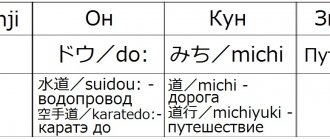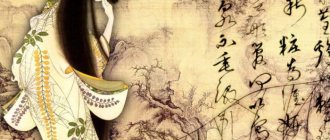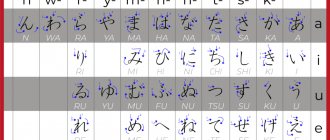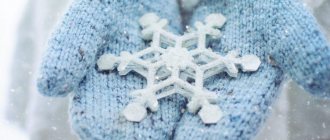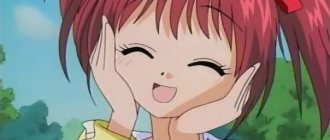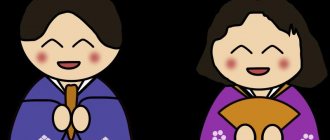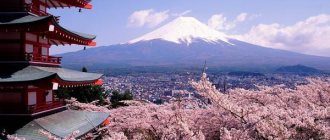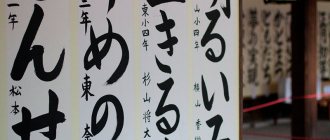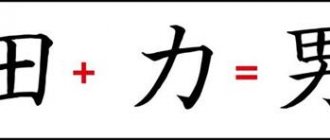Everything is relative. Happiness and sorrow, smiles and tears, a sense of unity and loneliness. Naturally, the situation is exactly the same with hieroglyphs. If there is any opposition, then the “kanji” seem to jump into your head. Let's try to take advantage of this. As you might have guessed, we invite you to get acquainted with the following “kanji”: “smile”, “kindness”, “emptiness” and “loneliness” .
If this is your first time discovering material on hieroglyphics, then pay attention to these articles on our website. These will be an excellent introduction to learning Japanese kanji :
Japanese characters
Keys of Japanese characters. Kanji in Japanese
How to write hieroglyphs. Order of features. Rules for writing hieroglyphs.
How to quickly learn Japanese characters
Effective ways to memorize Japanese characters. How to learn hieroglyphs and remember them!
"Smile"
The character 笑 can be broken down into two elements : "bamboo" ⺮ and "early death" 夭 at the bottom. The key by which the sign can be found in the dictionary is “bamboo” key No. 118 .
Pay attention to the order of strokes when writing a hieroglyph:
The hieroglyph reads as follows :
Him:ショウ
Kuns:わら(う) – laugh え(む) – smile
Originally, the 夭 element depicted a person waving his arms and throwing his head back in a dance. In the expression 夭折する (ようせつする; "to die young"), the "kanji" has a new meaning : it has changed from "young" to "to die young". It’s an unusual meaning for the element in the hieroglyph “to laugh,” you’ll agree.
Bamboo, which symbolizes the corresponding element, is a flexible and pliable plant. Here you can immediately see the connection between a flexible person in dance and flexible bamboo. Perhaps the ease of dancing generates a smile and laughter , hence the meaning of this “kanji”.
Words in which the sign occurs:
| Word | Reading | Translation |
| 笑覧 | しょうらん | Your favorable attention (reading, viewing) |
| 微笑 | びしょう | smile |
| 大笑み | おおえみ | loud laughter; burst of laughter |
| 笑顔 | えがお | smiling face; smile |
"Kindness"
The character 仁 consists of two elements : “man” 亻 on the left and “two” 二 on the right. The key is the element “man” – key number 9 .
They:ジン – love of humanity ニン ニ
This sign is very important for the culture of China, from where the hieroglyphs came to Japan. “Ren”, as it is read in Chinese, is a category of Confucianism meaning “philanthropy”, “generosity”, “kindness”. "Zhen" is one of the five highest virtues that a noble husband should possess. Expressed through caring for other people.
| Word | Reading | Translation |
| 仁徳 | じんとく | philanthropy, kindness |
| 仁義 | じんぎ | philanthropy and justice (preached by Confucianism); morality, code of conduct; duty; greeting ritual (especially among the Yakuza) |
| 仁術 | じんじゅつ | act of mercy; art of healing |
| 仁王 | におう | buddha “guardian of the gate”, guardian devas (two statues at the entrance to the temple) |
LiveInternetLiveInternet
Quote from PDAY
Read in full In your quotation book or community!
Japanese meaning of characters 2
Slightly different style...
Hieroglyph "Mind" | Hieroglyph “Nourish, nurture, develop” | Hieroglyph "Heart, soul" | ||
Hieroglyph "Samurai" | Hieroglyph "Hemp" | Hieroglyph "Writing" (in the broad sense) | ||
Hieroglyph "Silence" | Hieroglyph "Blessing" | Hieroglyph "generosity, forbearance, tolerance" | ||
Hieroglyph "Wealth" | Hieroglyph "Dragon" | Hieroglyph "Heart, soul" | ||
Hieroglyph “Path, road, Tao” | Hieroglyph "Tea" (Chinese handwriting "Zhuanshu") | Hieroglyph "Path" (Chinese handwriting "Zhuanshu") | ||
Hieroglyph "Wealth" | Hieroglyph “Family”, “Home” | Hieroglyph “wings” (feathered), “feather”, “plumage” | ||
Hieroglyph “happiness”, “luck”. Also “good luck in hunting, fishing, etc.” | Hieroglyph "love" | Hieroglyph “luck”, “prosperity”, “happiness” | ||
Hieroglyph "zebra with yellow eyes and red mane" | Hieroglyph “center”, “middle”, “middle” | Hieroglyph “harmony”, “peace”, “concord” | ||
Hieroglyph "Joy, fun" | Hieroglyph "Spring" | Hieroglyph "Devil, devil" | ||
Hieroglyph “ghost, ghost”, also “illusion, dream” | Hieroglyph "Wind" | Hieroglyph "Intuition, 6th sense" | ||
Hieroglyph "Love" | Hieroglyph "Silk" | Hieroglyph "Orchid" | ||
Hieroglyph "Believe" | Hieroglyph “Path”, “Tao” | The hieroglyph “Love” is perhaps the most popular and widespread hieroglyph in the world! | ||
Hieroglyph "Death" | Hieroglyph "East" | Hieroglyph "Buddha" (old form of the hieroglyph) | ||
"Instant Mind" This hieroglyph can also be translated as “thought, consciousness, attention.” | Hieroglyph "Good" | Hieroglyph “Dream, dream.” | ||
Hieroglyph "Reality, Truth, Truth." | Hieroglyph "Crane" | Hieroglyph "Fire" | ||
Hieroglyph "Pain" | Hieroglyph "Devil" | Hieroglyph "Sadness" | ||
Hieroglyph “Waiting” (“Wait”) | Hieroglyph "Love, passion" | Hieroglyph "Star" | ||
Silk | Bamboo flute | Spirit, energy | ||
Hieroglyph "Zen". The first element of the character means "Shinto deity", but it does not appear on its own. | Hieroglyph “Reality” (“Truth”, “Sincerity”) | Hieroglyph "Joy" | ||
Hieroglyph "Letter" | Hieroglyph "Happiness" | Hieroglyph "Word" | ||
Hieroglyph “Pure” (“Innocent”) | Hieroglyph "Woman" | Hieroglyph "Part" (of something) | ||
Hieroglyph “Thought” (“Idea”) | Hieroglyph “dance”, “flutter”, “fly” (may refer to the flight of a butterfly). | Hieroglyph "Eternity", "Infinity" | ||
Hieroglyph "Cheerful". | The hieroglyph “Firefly” was written as a gift to a good person. | Hieroglyph "Buddha". The left element is “person”, the right element is “I, personal”. | ||
Hieroglyph “Spirit, Life Energy.” Included in the word “AiKiDo” is the syllable “Ki”. | Hieroglyph "Flower" | Hieroglyph "Moon". Monday in Japanese is “Moon Day”. | ||
Hieroglyph "Snow" | Hieroglyph "Path" | Hieroglyph "Autumn Sky" | ||
Hieroglyph "Hemp". | Hieroglyph "Unicorn". | Hieroglyph "Blue, blue." | ||
Hieroglyph "Face". | Hieroglyph "Short-tailed bird." | Hieroglyph "Raw leather". | ||
Hieroglyph "Gold, Metal". In Taoism, Metal is one of the five primary elements. | The hieroglyph for “Wind” is “kaze”. This hieroglyph is used in the word "kamikaze" - "Divine Wind". | Hieroglyph "Heart". Its interpretation is interesting: the leftmost line is a hint of the right breast, the hook-shaped line is the outline of the left breast, and the two lines on the right side of the hieroglyph are the beat of the heart. | ||
Hieroglyph "Love". The hieroglyph consists of the elements “Woman” (left) and “Child” (right). | Hieroglyph "Sleep, sleep." | Hieroglyph “Shadow, silhouette, reflection, image.” | ||
Hieroglyph "Sheep". | Hieroglyph "Snow" | The hieroglyph “Shinto shrine” can also mean “Luck, Happiness, Prosperity” and contains the element “Shinto deity”. | Hieroglyph "sound" | Hieroglyph "Bird". Has similar elements to the hieroglyph “Horse” |
The hieroglyph “Window” combines the elements: (from top to bottom) “roof”, “common”, “heart”. If you try, you can come up with a rather poetic interpretation of this hieroglyph. | In the hieroglyph “Horse” you can immediately see the outlines of this animal: a mane, a long tail, four legs. This hieroglyph belongs to pictographic signs. | Hieroglyph "Sakura". The first element of the hieroglyph means “tree”, the second is definitely of a feminine nature. |
"Emptiness"
The character 空 is decomposed into two elements : “cave” 穴 on top, which consists of “lid” 宀 on top and “legs” 儿 on the bottom, and “craft” 工 on the bottom. The key of this sign is the element “cave” No. 116 .
Him:クウ
Kuna:そら – sky; air space あ(く) – to be empty (free, unoccupied); have a gap, have a gap; end, come to an end あ(ける) – release; empty から – empty, hollow, empty
The meaning of this hieroglyph is very well read by its elements. The 工 component in Chinese is responsible for reading the hieroglyph; it is a phonetic , and the upper element 穴 carries the semantic load. As you already know, it means “cave, emptiness, crevice, hole,” that is , where there is nothing . Hence the meaning of the sign.
| Word | Reading | Translation |
| 空想 | くうそう | fantasy, imagination; dreams |
| 空港 | くうこう | airport |
| 青空 | あおぞら | blue sky |
| 空手 | からて | empty hands; karate |
"Loneliness"
The hieroglyph 寂 can be divided into two elements : “lid” 宀 on top, which we already met in the previous hieroglyph, and “uncle” 叔 below. The key is the “cover” - No. 40 .
They: ジャク セキ
Kuns: さび – “sabi” さび(しい) – lonely; sad さび*(れる) – to decline
This character, along with the kanji 侘, is used in the word 侘寂 (わびさび; wabi-sabi, “humble simplicity”). If you have been interested in Japan for a long time, then you probably know what it means. Wabi-sabi is a category of the Japanese aesthetic worldview . They describe the simple, uncomplicated and imperfect beauty of something that is fleeting or will soon disappear. Rock garden and bonsai, tea ceremony, ikebana - this concept runs like a red thread through almost the entire Japanese culture.
| Word | Reading | Translation |
| 寂滅 | じゃくめつ | buddha nothingness, nirvana |
| 静寂 | せいじゃく | silence |
| 閑寂 | かんじゃく | peace; tranquility |
| 寂然 | せきぜん/じゃくねん | +たる lonely, abandoned |
Well, our article is coming to an end. We hope you found it useful and interesting. We believe that you are repeating the hieroglyphs that you met in our previous articles. If not, then run to study, don’t forget your old friends! Good luck in learning Japanese!
Japanese characters: “smile”, “kindness”, “emptiness”, “loneliness” - learn these “kanji” with us! We analyze spelling, readings and meanings.
How can you write hieroglyphs?
Japanese culture is special and unique. This is expressed in speech, everyday life and everyday life. Writing especially stands out. It is a synthesis of Chinese hieroglyphs and language, which was formed on the Japanese islands through the merging of foreign and native cultures. The art of writing kanji - calligraphy - stands out especially.
In everyday life, hieroglyphs are written with a pen or pencil. Be sure to write in pen on official documents.
This is roughly how it works to write with a pencil. The advantages are that they are quick and convenient, plus that a mistake can always be corrected with an eraser. For example, we take the character 夜 (よる yoru) night, late evening.
If a person is studying Japanese, then this is the most practical and reliable option.
When choosing a pencil, it is better to choose a mechanical one. It is very convenient for learning purposes and will be a companion for several years, so it is better to choose a high-quality pencil that will fit comfortably in your hand.
Example sentence:
Movie: wa yoru ni atarasiya hon o yomimasita) Yesterday evening I read a new book.
The picture above shows an example of writing a hieroglyph and text with a regular blue ballpoint pen. If you practice enough, it will turn out quite beautiful. Convenient and practical everyday option.
Offer in the photo:
Senjitsu wa sensei to eiga ni ikimashita) Na The other day we went to the cinema with our teacher.
Another interesting option is to write with a fountain pen. It will look most like a brush if you write with black ink, but you can choose any color from the standard ones or order your own shade. There are special inks for mixing colors to create your own color and special style. Even a not very expensive fountain pen looks beautiful and solid. It is advisable to choose an F or FF pen, then the kanji will be written clearly and legibly.
The photo shows an example of writing kanji with an F pen and black ink.
It is a good choice for people who can write Japanese fluently and accurately.
The photo below is an example of writing with a FF pen and blue ink.
You can choose not only a classic style handle, but also a more elegant one.
Another option for beautiful and neat writing is a calligraphy liner. This is a regular alcohol liner, but it has a brush as a writing unit. These liners come in a wide variety of colors. There are even ones with a metallic sheen.
Black liners come in three sizes - small 小, medium 中 and large 大. The size of the writing brush is written on the cap of the liner in the corresponding hieroglyph.
Writing regular texts is convenient for the smallest of them.
The photo below is an example of a lecture text on the Japanese language, in which Japanese examples are highlighted with a small liner.
The next photo shows an example of writing with a small calligraphic liner.
Larger liners can be used for design work and highlighting headings.
The photo shows the proposal
Yesterday I walked the dog.
And, of course, those who like to write hieroglyphs beautifully will be pleased with a good calligraphy set.
Liners with metallic shades look interesting, as in the next photo. The inscription is made with a large liner.
Captions on the photo:
読みました。(よみました yomimasita) Read.
I love the Japanese language very much.
常用漢字 (じょうようかんじ joyokanji) “Joyo kanji” (official list of 1945 commonly used characters).
The metallic liner brush looks like this photo.
This is a useful read:
- Japanese language. There are 20,000 of us! Free webinars on Japanese
- Performing an action with a purpose
- Kirigami. The art of paper cutting by Akira Nagaya.
Tagged kanji liner for calligraphy how to write hieroglyphs Japanese calligraphy Japanese hieroglyphs Japanese hieroglyphs and their meaning Japanese hieroglyphs pictures Japanese hieroglyphs in Russian Japanese hieroglyphs with translation Japanese hieroglyphs

